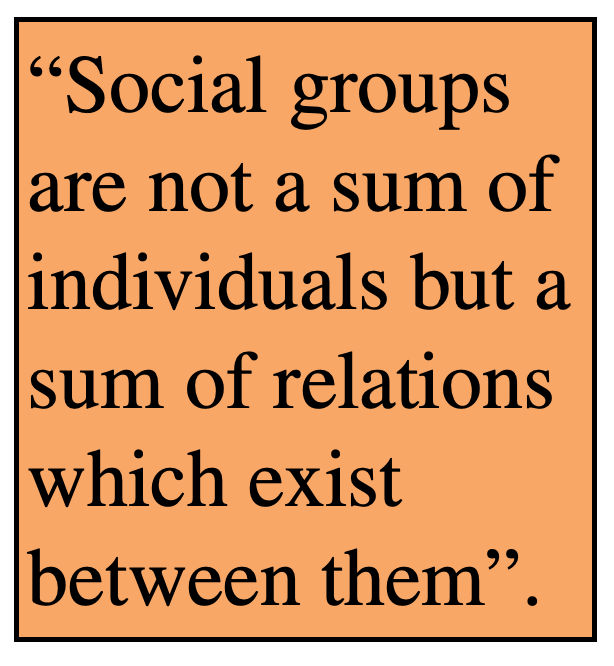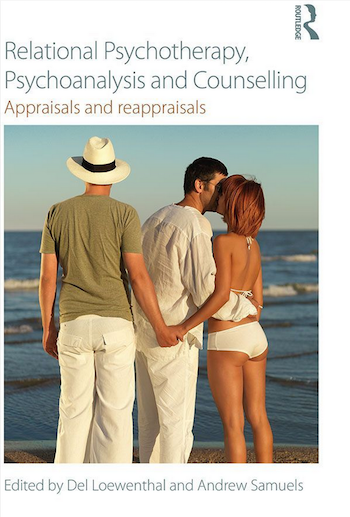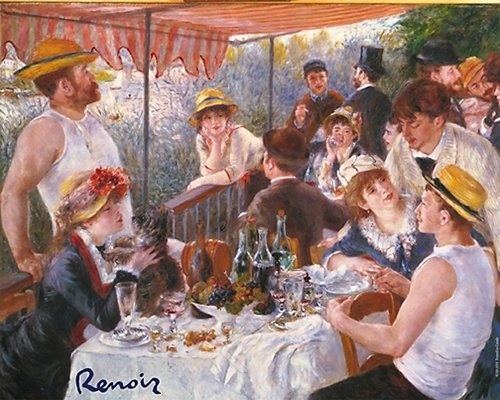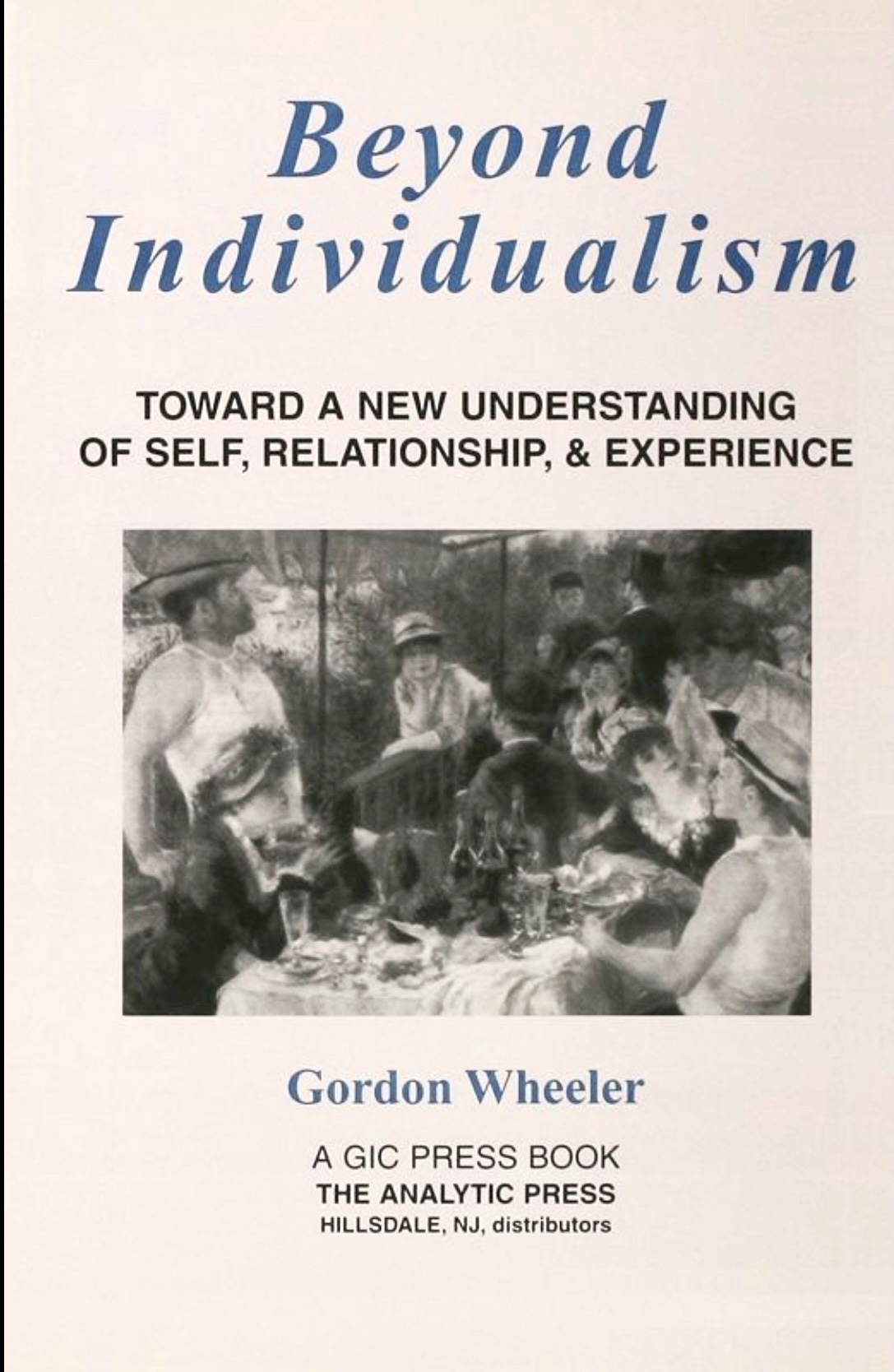People often talk about the inner world and inner work. ‘Inner’ is not a good word to use. The reason? It obscures the relational aspect of these experiences. Both their origins and new revelations. Our experiences do not come from within. We are impacted, again and again. Continue reading “A short reflection on the word “inner””
“Between” should not vanish into a “within”.
Talking about Moreno’s approach, German sociologist Leopold Von Wiese, (1949) said:
“the realm of subjectivity is never given up by him. But the use of the word subjective here should not imply that Moreno is limited in his studies by a personal involvement; it is just the opposite. His aim is directed towards the most exact objectification of observations; but the object of these operations is the realm of the human psyche exclusively. This is so perhaps because he is a psychiatrist, a practical psychologist and physician. We too, in our “system of relations” do not neglect the psychological processes; but their penetration is one of several tasks so that we can recognize that realm of existence which. is crucial; the social one which lies between men and not within them. Particularly when one, as Moreno, like ourselves, emphasizes the significance of the little word “between” one should not permit it to vanish into a “within”.”
I like this as a formulation of the relational paradigm.
More on this theme from Von Wiese:
“When we try to reproduce here the chief content of Moreno’s work, we may best start With a statement from White’s foreword to it, one Which is also an axiom of our system of relations: “Social groups are not a sum of individuals but a sum of relations which exist between them”.
Which makes them complex beyond imagination.
Von Wiese, Leopold. (1949). “Sociometry.” Sociometry, Vol. 12, No. 1/3 (Feb. — Aug, 1949), pp. 202—214 Published by: American Sociological Association https://www.jstor.org/stable/2785387
Relational paradigm – Bruce and Francine
I think they nail it here:
“Imago shifts the focus from the self to the relationship and posits “relationship” as fundamental reality of which individuals are derivatives. To embody this paradigm shift, partners must shift their focus from their own need gratification to the needs of the relationship. The paradoxical outcome of that counter-intuitive shift is that such a sacrifice will insure the satisfaction of their needs in a way that was not possible when the focus was on the self. When the couple becomes partners rather than opponents in the project of creating and enacting their dream relationship, they create a thriving relationship. This perspective rests on the assumption that human beings are intrinsically relational, that the human problem is relational rupture, that all emotional symptoms are expressions of relational anxiety and that relational repair is the only and sufficient path to human well being.”
Beauvoir, Francine; Crapuchettes, Bruce. Getting Back The Love We Had: Forty-Two Answers To Real Questions From Couples Who Feared They Were Losing Their Way (pp. 4-5). Kindle Edition.
Couple and family therapy – Interpsyche
Here is a quote from Moreno that has major implications for how we conduct psychodrama in groups or with individuals when they want to work on significant relationships and the other party is not present. Can we trust their representation?
Can a person in a couple relationship role reverse with their partner?
In a group can someone do a drama involving an intimate other who is not there?
These are questions I will be exploring in action with colleagues. in a workshop at the AANZPA conference in Brisbane in January.
Marriage and family therapy for instance, has to be so conducted that the “interpsyche” of the entire group is re-enacted so that all their tele-relations, their co-conscious and co-unconscious states are brought to life. Co-conscious and co-unconscious states are by definition such states which the partners have experienced and produced jointly and which can therefore be only jointly reproduced or re-enacted. A co-conscious or a co-unconscious state can not be the property of one individual only. It is always a common property and cannot be reproduced but by a combined effort. If a re-enactment of such co-conscious or co-unconscious state is desired or necessary, that re-enactment has to take place with the help of all partners involved in the episode. The logical method of such re-enactment a deux is psychodrama. However great a genius of perception one partner of the ensemble might have, he or she can not produce that episode alone because they have in common their co-conscious and co-unconscious states which are the matrix from which they drew their inspiration and knowledge.
Psychodrama Volume 1, 4th edition, page vii
In short…
Couple and family therapy has to be so conducted that the “interpsyche” of the entire group is re-enacted so that all their tele-relations, their co-conscious and co-unconscious states are brought to life. Thus the interpsyche involves states which the partners produced jointly and which can therefore be only jointly reproduced, by a combined effort. The logical method to re-enact an episode in the life of a couple is psychodrama. However great a genius of perception one partner may be, he or she can not produce that episode alone because they have in common their co-conscious and co-unconscious states which are the matrix from which they draw their inspiration and knowledge.
The logical method of such re-enactment a deux is psychodrama.
Later — Friday, 22 December, 2017
Just noticed this quote fro Marshall Rosenberg:
It may be most difficult to empathize with those we are closest to.
Moreno was not alone in noticing this phenomena
Ubuntu – A person is a person through other people
https://en.wikipedia.org/wiki/Ubuntu_(philosophy)#Definition
According to Michael Onyebuchi Eze, the core of ubuntu can best be summarised as follows:
“ ‘A person is a person through other people’ strikes an affirmation of one’s humanity through recognition of an ‘other’ in his or her uniqueness and difference. It is a demand for a creative intersubjective formation in which the ‘other’ becomes a mirror (but only a mirror) for my subjectivity. This idealism suggests to us that humanity is not embedded in my person solely as an individual; my humanity is co-substantively bestowed upon the other and me. Humanity is a quality we owe to each other. We create each other and need to sustain this otherness creation. And if we belong to each other, we participate in our creations: we are because you are, and since you are, definitely I am. The ‘I am’ is not a rigid subject, but a dynamic self-constitution dependent on this otherness creation of relation and distance”.[9]
WOW
Therapeutic Tele
I found a few pages in Psychodrama Vol I by J.L Moreno – I think this item was written well before 77 when the book came out – a Symposium in the 40s?
Moreno talks of the individual locus of physical ailments. There is another locus for psychological work, the relationship.
Then he gets really radical. The relationships in life are therapeutic. The psychodramatist activates the healing potential of the relationships.
And then there is one more thing!
“the medium of therapy [is separate] from the healer as well as the group therapeutic agents.
What is that “medium” – Moreno in other places calls it the sociometric matrix.
Here is how I sum up Moreno’s philosophy: there is a network of social and cultural role patterns we are born into. Born out of perhaps, that is the matrix. Spontaneity is our ability to transcend that given.
Here is the selection in Google Drive. It should be public – if not email me.
Thus the healing is in the relational paradigm. (an imago book)
Notes on Gordon Wheeler’s Book: Beyond Individualism
Somehow I found this book and purchased the Kindle edition It exactly relates to what I’m thinking about about the moment.
Continue reading “Notes on Gordon Wheeler’s Book: Beyond Individualism”
The Relational Paradigm.

Three articles on the relational paradigm were published in the Imago newsletter this year by Harville Hendrix and Helen LaKelly Hunt. They are available on the Imago website. I have collated them here as I wish to refer to them in my writing on this blog and in discussion with others.
UPDATE: Wednesday, 9 March, 2016
Added a fourth article from the March Newsletter.
Book: Relational Psychotherapy, Psychoanalysis and Counselling: Appraisals and reappraisals — ed: Del Loewenthal, Andrew Samuels
Relational Psychotherapy, Psychoanalysis and Counselling: Appraisals and reappraisals [Kindle Edition] Del Loewenthal (Editor), Andrew Samuels (Editor)

In the light of the last post I’m keen to read this book and pleased its in Kindle format. The image on the cover is evocative! It shows well the potential for psychotherapy to create ambivalence in a relationship.
“Relational” TA and psychoanalysis, psychodrama and the relational paradigm
I have been looking up anything to do with the relational paradigm and keep bumping into relational psychoanalysis and relational T.A.
They seem fine. I’m surprised these branches of the tree are even needed – I would have thought that psychoanalysis and T.A. Were already “relational” in this way, i.e. Valuing of the relationship between the therapist and the client. Understanding attachment and early relationships as primary. Apparently not.
However I realise I’m in a different school altogether. One that see the relationship as the therapy, but not only the relationship with the therapist but the relationship people have with each other out there in the world. The marriage or committed loving relationship is the dominant one. I’ve come to understand that, especially in individual therapy, the relationship with the therapist can undermine the potential of the committed loving relationship with a partner. If there is no such relationship then the relationship with the therapist can be a surrogate, or if possible a way of facilitating the search for a mate. The rest of the time the therapist is there to facilitate the consciousness that will enable a committed loving relationship to be therapeutic. They are not naturally so – though they have a natural propensity to be so.
With this relational paradigm more and more fully grasped of late I see that psychodrama has something of this philosophy well developed. Moreno speaks a lot of “in situ”. I think of that as working with the actual here and now relationships in a group.
Psychodrama does not require a theatrical setting, a frequent misunderstanding; it is done in situ – that is, wherever the subject is found.
Who Shall Survive? (1978) P86
However Moreno is not clear on this – Later in the same book he speaks again of therapy in situ
… it can take an immediate form, in situ, that is, in the course of all activities in which the individuals are en- gaged, in the home, in school, at work, for instance the handicraft shop, steam laundry, carpentry shop, department store, etc . The situations of living and working are at the same time used as therapeutic settings. We have found, however, that the analytic and activistic forms of group psychotherapy are not applicable to the deepest disturbances of the individual and the group; they require the application of deep action methods in the form of psychodrama. But they are applicable to social problems of the group in a setting in which, during the treatment, the group is artificially cut off from the community as if the rest of the community were non-existent and as if the influence coming from it could be disregarded.
He comes close to a relational paradigm, and then moves away for “the deepest disturbances of the individual and the group” to theatre where psychodrama clearly becomes treatment of or via a protagonist. Yet he stays close, because as we know, … the protagonist is a protagonist for the group. (ref?)
The idea that the relationship itself can be the source and vehicle for growth and healing, is not explicit in psychodrama – it is there in most psychotherapy, but only in the relationship between the client and the therapist. Yet this idea that the protagonist is working for the group can be translated to the protagonist working for the relationship. That helps!
The relational paradigm is still to have its major impact, like any paradigm shift it is hard to get from the perspective of the old space.
Imago dialogue is one technique for activating relational healing, one that is easy to teach to clients. However I think T.A. Has the potential for that, Marshall Rosenberg NVC, and psychodrama does as well… Concretisation, role reversal, mirroring and doubling are potent methods. Psychodrama is not so easy without a director. How make the method easily accessible is what I’m working on all the time.


